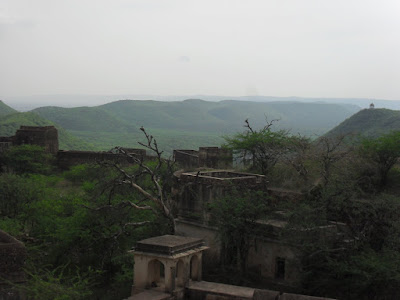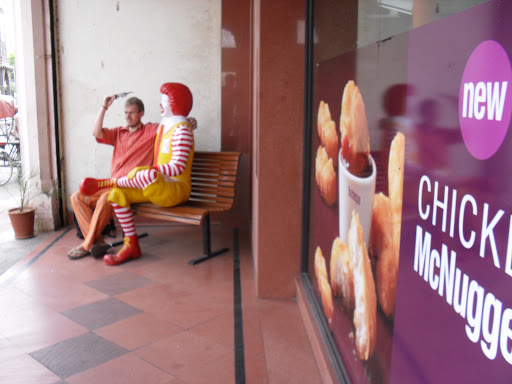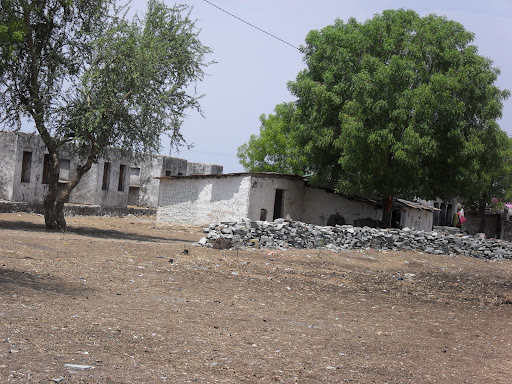
With Rick’s stomach still a bit at ease, the two of us decided to take the shortish trip to the small town of Bundi for a quick weekend getaway. Along the four hour midday ride (we took the cheaper/slower/hotter/more crowded, but still pleasant, government bus system), I got a chance to see the closest major city, Kota, during the day for the first time. The city, like most of rural India I’ve seen, looked dirty and unkept. It’s not that I think all cities should mirror Pleasantville, but the public spaces there and elsewhere just seemed remarkably disregarded for a country whose government occupies such a massive part of people’s daily lives. The all over trash and tainted stagnate water reminded me of the numerous volunteer trash clean up efforts back home.
We dined at a fantastic rooftop restaurant (setting a weekend tradition we’d strictly begin following: they’re great places to meet other travelers, here we would find four Chileans on winter holiday). My pene pa sta with freshly made to mato sause (yet to find an Indian menu with under a dozen hilarious English errors) was excellent and I’d order it three times that weekend. We were approached by an only slightly sketchy man who led us to his nearby guest house, where we agreed to stay the night.

We woke up the next day to find we were right next to the base of the steep city palace/fort hill. We set off for the palace, which was still occupied by the current Maharaja but is semi open to the public. The views of the waking city were great and the foreigner entry fees were bearable. A great weekend was in progress.

We walked to the markets, stumbling upon some sort of street celebration where a DJ dropped beats through big tuktuk speakers and some guy in the middle of a dancing crowd threw out money and flowers. The markets, unfortunately, weren’t as exciting; just the same old same old shitty little retail shops you see every ten feet in India.

Made our way to the 84 Pillared Cenotaph, a 60 foot alter type thing. At the top of the steps, people were sleeping all about the cool floor (just like at the Patan temple) and on the highest open air platform were half a dozen twenty something Indian guys. The only people awake in the cenotaph, we talked (roughly through the language barrier) about college and money and phones and Indian/Westerner marriage and cricket and got the lowdown on being young in India.

Around this time, we decided to treat ourselves to a nice hotel. When told about our booking a two bed, AC room at Bundi’s largest three star hotel (with an awesome awesome pool) for only two thirds the going rate (because we were the ONLY customers and business is slow in the off season), strange guest house man kind of flipped and wanted us to pay for a second night anyways. Needless to say, we deliberately avoided meeting him for our preplanned fort tour that night. Things involving the guy were awkward enough.

We made the long hike up the hill, passing the city palace along the way up. The fort in Bundi is like a scene out of the video game Ico. Gigantic centuries old stone water reservoirs (you could fit a small basketball court in them) dot the complex along with overgrowth, crumbling towers, high walls, and walking paths on and along the structures. Save for two French girls and an Indian lawyer, we were the only souls around; a very surreal hike with all the huge ancient buildings around and all. From the fort level, you can see the entire city, along with the city palace ~150 feet below. We also ran into a few police dispatch workers who invited us up to the very highest tower (now used as an emergency dispatch center) from which you could see our hotel and the cenotaph, miles away.

Enjoying the view of the surrounding Jungle Book forests, we sat down on top of one of the higher towers and were then joined by three big monkeys. We kinda all stared at each other in a sort of old fashioned Texas standoff. Man vs Ape, they would all flinch everytime I'd make a sudden movement and Rick and I were both crouched and ready to fight for our lives if the damned dirty apes attacked. Rick took off his shoes and held them in the air. I clutched some gravel rocks I'd picked up at the base just for that reason and insulted them for never figuring out the wheel or fire.
In the end, we all cooled down and enjoyed the view together peacefully.

^The green courtyard on the right side of the palace is the same one as in the second picture above.













































